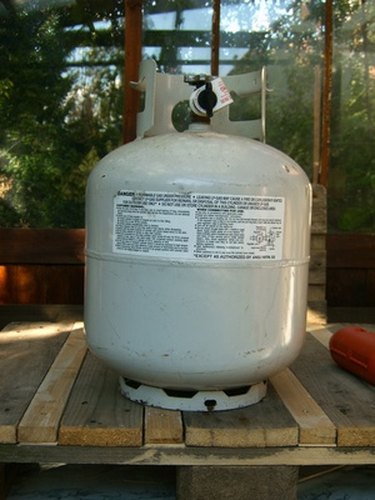
Filling propane tanks is a process that must be handled with care to prevent problems such as explosions, leakage and damage to the propane tank. If it is not properly filled, the gas inside the tank can become unstable and cause major issues. OSHA has specific requirements that must be met in all U.S. states to ensure that the general public is best protected from harm.
Valve Caps
Video of the Day
Propane cylinders either come with a valve cap or built-in valve protection to prevent leakage and explosion. The valve cap must be on at all times according to OSHA standards. This cap is a ring that is placed on the top part of the tank where the propane is physically pushed into the tank when it is being filled.
Video of the Day
Filling Standards
OSHA also has requirements regarding how full a tank can be. OSHA also requires that a "WC" (water capacity) stamp be on the outside of the propane tank. The water capacity indicates the amount of weight in water that can safely be placed inside the tank. In addition, there will be a number, typically "47.6" for a barbecue grill propane tank, which indicates that the tank will hold 47.6 pounds of water. There will also be a "TW" (tare weight) stamp on the outside of the tank, indicating the weight of the container when it is empty. This is also followed by a number such as "18," meaning that the bottle weighs 18 pounds when it is completely empty.
These numbers are very important because they help the person filling it determine how much gas can safely be filled in the tank. The propane filling station will have a chart that will determine how much weight of propane gas can be entered into the tank.
Inspection
OSHA also regulates that all propane tanks be regularly inspected. A yearly inspection is recommended for all home propane tanks, such as barbecue grill tanks, and commercial propane tanks are required to have an inspection every 12 months. The inspection date and details (such as location and inspector number) are required to be printed on the side of the propane tank in commercial propane tanks. For personal-use propane tanks, the tank is visually inspected each time it is filled. The propane filling stations are responsible for doing a thorough inspection of the tank before gas is placed inside it. Any damage to the outside of the tank (such as dents or deep scratches), damage to the valve cap or the filling cap at the top of the tank indicates that the tank needs to be completely replaced and should no longer be used. If this is the case, OSHA also has specific requirements for disposing of the used tank that must be followed stringently by the propane filling station.